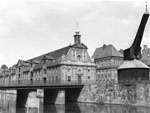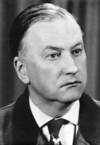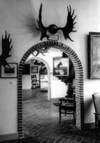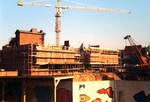History of the Museum
After World War II, Lower Saxony became the main settlement area for millions of refugees from the eastern parts of Germany beyond the rivers Oder and Neisse.
The Lüneburg area was sometimes referred to as "Klein- Ostpreußen in der Lüneburger Heide" (Little East Prussia in the Lüneburg Heath), because many people from East Prussia settled there during the 1950s. Besides struggling with the harsh living conditions and trying to rebuild their lives, the destitute and displaced people attempted to preserve their cultural identity at the same time.
Together with other East Prussians, forest superintendent Hans- Ludwig Loeffke, born 1906 in Tilsit, founded the Ostpreußische Jagdmuseum (East Prussian Hunting Museum) in the Lüneburg "Kaufhaus am Alten Kran" (Department Store at the Old Crane). It was dedicated to the topics of wild game, forest and horses in East Prussia.
 |
A year later, it fell victim to arson. The damage was so severe that only a few exponates could be saved. In his novel "Heimatmuseum" (Local Museum) published in 1978, Siegfried Lenz described a fire in an East Prussian museum.
Hans- Ludwig Loeffke dies in 1974. Horst Albinus becomes honorary director.
In 1981, the subject area is extended and the museum renamed to "Ostpreußisches Jagd- und Landesmuseum (East Prussian Hunting and Regional Museum) in anticipation of the development of the "Grundsatzkonzeption zur Weiterführung der ostdeutschen Kulturarbeit" (Basic Concept for the Continuation of East Prussian cultural Activities) which stipulates the foundation of regional museums for the East Prussian regions.
In 1985, the art historian Dr. Friedrich Jacobs takes over the management of the museum full-time. Together with three- initially temporarily employed- academics, he develops a concept for the new museum building that had already been under construction at Ritterstraße 10 for the last two years. The architect is the German-Baltic Dipl.-Ing. Richard Westrén- Doll.
1987 Opening of the new building with 3000 sq. floor space and the nearly finished permanent exhibition. The further museums work is now guaranteed by the sponsorship of the Federal Government and the Land of Niedersachsen based on § 96 (BVFG)
1990 The folklorist Dr. Anja Benscheidt becomes the new director.
1991 The historian Dr. Ronny Kabus takes over the management of the museum.
1994 The sponsorhip of the museum passes on from the association "Ostpreußisches Jagd- und Landesmuseum e. V." to the "Ostpreußische Kulturstiftung".
2005 The art historian and current deputy Dr. Jörn Barfod replaces the director.
2009 The historian Dr. Joachim Mähnert fills the position of director which had been vacant for several years.
Since 2009
After resolving on a new concept for the museum, the integration of a German-Baltic department was decided on in 2010. This happens in close cooperation with the Lüneburg- based Deutschbaltischen Kulturstiftung (East Prussian Cultural Foundation), as well as with the Nordost-Institut (Institute for Culture and History of the Germans in Northeast Europe- registered association- at the University of Hamburg) which is the central research institute for the Baltic. The permanent exhibition is to be modernised as well. Two new galleries, themed "The Integration of the Displaced People after 1945" and "The Preservation of the German cultural heritage in East Prussia and the Baltic today", will be added. For this, the Ostpreußisches Landesmuseum (East Prussian Regional Museum) is planning a rebuilding and an extension with a new main entrance at the Heiligengeiststraße. The building at number 38 and the parcel of land at the back, which had already been purchased in 2008, are the basis for this extension. The start of the construction works is planned for 2013 and the completion for 2015. The architectural practice "Sunder-Plassmann" in Kappeln has been commissioned to carry out the project.











